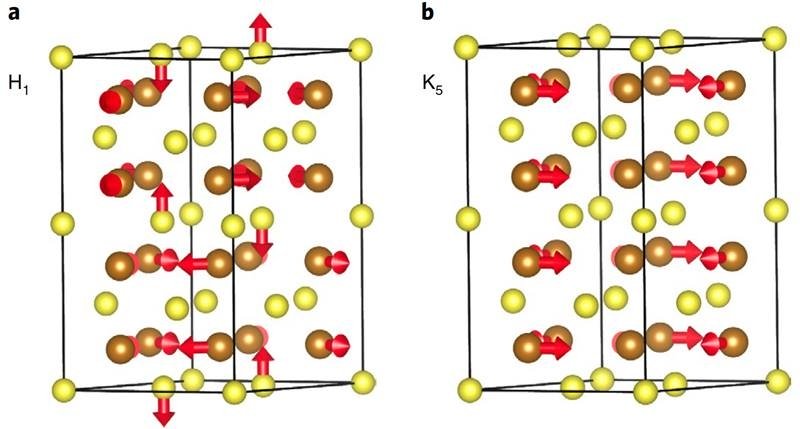The Science
Hexagonal iron sulfide is a type of multiferroic – a versatile material with both magnetic and ferroelectric coupling. Multiferroics are rare but useful for a range of novel device applications. Combined use of neutron and x-ray scattering, coupled with computational modeling, revealed that the ordering of magnetic spins on iron atoms upon cooling destabilizes the vibrations of atoms (H1 and K5 modes in figure). This in turn leads to a structural distortion and an opening of the band gap, causing a transition from a conducting to an insulating phase.
The Impact
This discovery provides a new route to design materials with tunable electrical and magnetic behaviors for potential applications in information storage and spintronics computing.
Summary
Understanding the interplay of spin, phonon, and charge degrees-of-freedom is critical to controlling a wide array of quantum materials. Hexagonal iron sulfide (h-FeS) is an interesting material with coexisting magnetic, structural, and metal-insulator transitions in a simple stoichiometry, as well as proposed magnetoelectric coupling. This offers a perfect model system for studying emergent behavior of materials such as its metal-insulator transition. This research explored the microscopic mechanism for this transition by the combined use of neutron and X-ray scattering experiments at the Spallation Neutron Source and Advanced Photon Source. Analysis of the experimental results, combined with computer simulations, established that the ordering of magnetic spins on Fe atoms upon cooling destabilizes the atomic vibrations of atoms. Strongly anharmonic lattice vibrations, that is, vibrations exhibiting non-periodic motion, associated with unstable phonon modes are controlled by magnetic ordering of spins, and in turn provide a means for the structural distortion that tunes the band-gap. Thus, spin-phonon and electron-phonon couplings are key to enable the sequence of phase transitions in h-FeS. The new understanding of the magnetic spins of Fe atoms and the atomic vibrations of the crystal lattice provides a novel avenue to design materials with controllable magnetoelectric properties for future information processing and storage devices.
Funding
This work was supported by the U.S. Department of Energy (DOE) Office of Science, Office of Basic Energy Sciences, Materials Sciences and Engineering Division, under an Early Career Research Program award. Sample synthesis was supported by the National Science Foundation. The Spallation Neutron Source and High Flux Isotope Reactor at DOE’s Oak Ridge National Laboratory and the Advanced Photon Source at Argonne National Laboratory are DOE Office of Science user facilities. Theoretical calculations were performed using resources of the National Energy Research Scientific Computing Center, a US DOE Office of Science user facility at DOE’s Lawrence Berkeley National Laboratory.



